The presentation uses original author's terms that more accurately convey the meaning of socionic categories. Generally accepted terms (alas, poorly conveying meaning) are given in brackets [] for comparison.
contents:
- Part 1. Functions
- Part 2. Dichotomies ("Reinin's features")
- Part 3. Socionic functions and sociotypes as strategies of survival
- addendum 1. Comparison of semantic content MBTI and socionic functions
- addendum 2. Relative dispersion contribution of 15 socionic dichotomies to the overall diversity of personality traits
- addendum 3. Recommendations for typing diagnostics
- addendum 4. 60 various personal properties and character accentuations in the socionic coordinate system
Part 1. Functions
Important for a correct understanding of the following: in some socionic schools, signs of functions are used in order to give the functions of one or another semantic shade - in connection with the influence of third Reinin's features (complication - simplification or contentment - discontent). We completely reject such an approach. We use signs for functions (also as for dichotomies) in a purely mathematical sense: plus means an excess of a function, minus means a deficiency.
1-4) survival functions
[БИ] = "white intuition"/ M: imagination of metamorphosis
most M (IEI, ILI): +M: observing changes and waiting for the moment, adaptation to unpleasant circumstances and superior forces, equivocation
least M (ESE, LSE): −M: diligence, regular care, guardianship of loved ones, mundanity, doesn't anticipate any trouble
[ЧИ] = "black intuition" / A: imagination of alternatives
most A (ILE, IEE): +A: "childishness", curiosity, seeing new possibilities, innovation, love of freedom and willingness to give freedom
least A (LSI, ESI): −A: severity and "solidity", focus on past experience, prohibition of alternatives, imposition of restrictions and punishments
[БС] = "white sence" / H: sense of homeostasis
most H (SEI, SLI): +H: focusing on the present, relaxation, striving to comfort & convinience and to avoid any conflict or crisis
least H (EIE, LIE): −H: striving for the future, following long-range purposes, tension, accelerating, searching for crisis to use them to yours advantage
[ЧС] = "black sence" / D: sense of domination
most D (SLE, SEE): +D: desire to win here and now, striving for dominance & lust for power, offensive aggression, willingness and ability to use violence
least D (LII, EII): −D: altruistic desire to preserve the possibilities for a future's life, humanism, non-possessiveness, honesty, hesitancy, shyness
5-8) control functions
[БЛ] = "white logic" / L: calculation of laws
most L (LII, LSI): +L: analyticity, systematization, paradigmatic thinking, impartiality, denial of compromises
least L (SEE, IEE): −L: sociability, social manipulativeness, flattery & charm "specially for you", inconsistency and thoughtlessness of actions
[ЧЛ] = "black logic" / P: calculation of profit
most P (LIE, LSE): +P: professional specialization, focus on efficiency, time savings and monetary benefits, utilitarianism, workaholism
least P (SEI, IEI): −P: the ability to create a mood, art decorativeness, susceptibility, sensitivity, capriciousness, seeking patronage
[БЭ] = "white ethics" / R: suggestion of relations
most R (ESI, EII): +R: deep ethical analysis of the personality, tactfullness, devotion which motivate loved ones, shame and guilt feelings
least R (ILE, SLE): −R: tactlessness, straightforwardness, sharpness, audacity, early emancipation, radicalism, revolutionary
[ЧЭ] = "black ethics" / S: suggestion of synchrony
most S (ESE, EIE): +S: expressive behavior to motivate people masses, involvement in public life, following fashion, striving for the ideal of attractiveness
least S (ILI, SLI): −S: self-concealment, individualism as non-involvement, indifference, unemotionality, critical thinking
9-12) functions of self-positioning in society
[БК] = "white questimity" / I: separation of independence
most I (LII, ESI): +I: low stress resistance, social separation, moral fastidiousness & striving for moral purity, defense of personal freedom and justice
least I (SLE, IEE): −I: herd instinct, patriotism & nationalism, any propaganda, pack bullying, approval of generally accepted corruption schemes
[ЧК] = "black questimity" / E: separation of exclusivity
most E (EIE, LSE): +E: elitism, irritation of discomfort, squeamishness for low quality resourses, aversion to the lower, alien and sick, indignation
least E (SEI, ILI): −E: universal acceptability, collaborationism - ready to use anything for survival, tolerance for human oddities, sins and any bodily dirt
[БД] = "white declatimity" / O: acceptance of subordination
most O (LSI, EII): +O: collectivism, obedience for majority opinion & all-recognized authorities, patience, resignation to fate, conservatism
least O (ILE, SEE): −O: nonconformism, impatience, acts contrary to the majority, individualism as a bright personal originality, reformist potential
[ЧД] = "black declatimity" / C: acceptance of collaboration
most C (ESE, LIE): +C: intergroup exchange of equals, willingness to involve and get involved in any business, good understanding yours and others goals
least C (IEI, SLI): −C: detachment, doubts about one's essence, search for special ways and doing original works, desire for privilege for one's craftsmanship
Averaged values of socionic functions for real representatives dyfferent types:
(the figures show the relative deviation of the values of the function from the average population, averaged on all people with this type being the leading one)
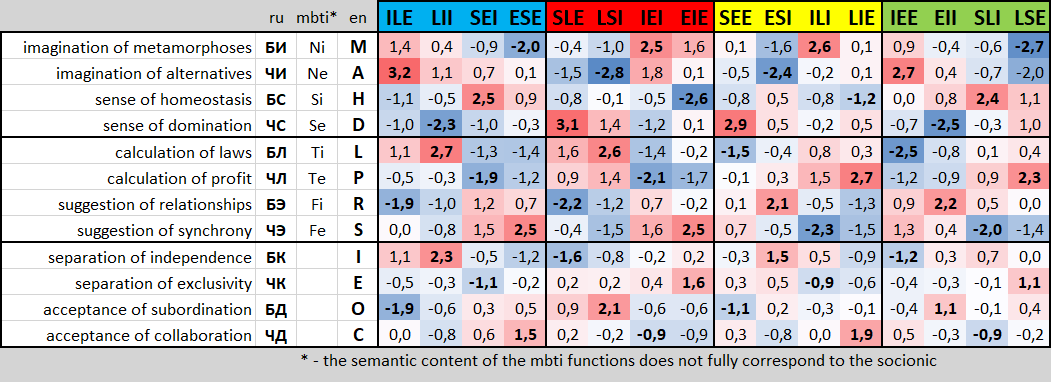
Part 2. Dichotomies ("Reinin's features"):
Real (given below) the semantic content of the dichotomies is based on the analysis of the statistics of Talanov's large questionnaires.
Dichotomies that determine the strength of functions:
a [логик/этик = "logical/ethical"]: "thinking - feeling", orientation to objects - to subjects, formal logic - cognitive empathy, calculation - suggestion (incl. autosuggestion). Suggestion pole is characterized by a more generalized excitation of the nervous system, and calculation pole is more local (the functioning of the brain is more like a computer). The extreme forms of manifestation of the calculation pole is schizoid personality disorder and antisocial personality disorder. Histrionic personality disorder contains features of the suggestion pole.
b [интуит/сенсорик = "intuitive/sensor"]: imagination - sense, abstractness - concreteness, mentality - physicality. Imagination pole differs in wider perception filters (which allow more signals to pass through - both allowing to detect something useful or dangerous in advance, but also containing more errors of perception), and the sense pole - narrower perception filters (which allowing to better control movements of body and identify habitual signals environment). The extreme form of manifestation of the imagination pole is schizotypal personality disorderlink.
c [квестим/деклатим = "asker/declarer"]: separatness - acceptance (of unity): divergention - convergention, irritation - patience, disgust - indiscrimination, distancing from someone else's - accepting someone else's, creation of the original - competition of copies, personal uniqueness - mainstream (unity of commoners). Belonging to the separateness pole is associated with a narrower area of the personally permissible (such that everything that falls outside the boundaries of this area is rejected). Probably, acceptance pole is largely characterized by increased vasopressin activity in the central nervous systemlink.

Types of thinking:
- calculation + imagination = abstract-symbolic (goal - changing the objective world by developing and implementing new technologies);
- suggestion + imagination = abstract-figurative (goal - changing the internal state, mood and attitudes of people by inspiring them with artistic images);
- calculation + sense = subject-instrumental (goal - changing the objective world by doing mechanical work - construction and destruction material objects);
- suggestion + sense = visually-figurative (goal - changing the body condition of people by providing them with the material resources - food, clothing, housing, etc).
Divergent thinking means the search and invention of new knowledge, technologies, ways of self-expression and reproduction of offspring. For divergent thinking, the concept of authorship is key, the author takes all the risks, creating something away from the mainstream and not knowing whether it will be in demand in society.
Convergent thinking means using standards and technologies that have already been developed and proven to be relevant. For convergent thinking, it is important not to be original, but to copy, adapt and reproduce technologies, knowledge, plots and norms of behavior that are already in demand faster and better than competitors.
- divergent abstract-symbolic thinking is present in knowledge types {ILE, creator of knowledge + LII, keeper of knowledge}. These types form a scientific picture of the world through the competition of independent thinkers.
- convergent abstract-symbolic thinking is present in business types {LIE, creator of business + ILI, keeper of business}. These types maintain a market unity.
- divergent abstract-figurative thinking is present in art types {EIE, creator of art + IEI, keeper of art}. These types form a high art through the competition of independent artists.
- convergent abstract-figurative thinking is present in culture types {IEE, creator of culture + EII, keeper of culture}. These types maintain a language-cultural unity.
- divergent subject-instrumental thinking is present in production types {LSE, creator of production + SLI, keeper of production}. These types form a ergonomically perfect environment through the competition of independent craftsmen.
- convergent subject-instrumental thinking is present in force types {SLE, creator of force + LSI, keeper of force}. These types maintain a state unity.
- divergent visually-figurative thinking is present in ownership types {SEE, creator of ownership + ESI, keeper of ownership}. These types form the features of the appearance of people through sexual and political competition of independent appearance appraisers.
- convergent visually-figurative thinking is present in nature types {ESE, creator of nature + SEI, keeper of nature}. These types maintain the unity of the appearance of the population, adapting it to the natural habitat of this population.
Dichotomies that determine attractiveness of functions for the person (defining quadra values):
ac [рассудительный/решительный = "judicious/decisive"]: peacefulness - rivalness, altruism - selfishness, kindness - evil intent, giving away - usurpation, relaxation - escalation, care - parasitism. The rivalness pole is characterized by a higher level of endorphin release in response to stress, which in some cases can lead to a special search and provocation for stress factors (endorphins addiction)link. Rivalness pole a correlates with traits of the dark triad (machiavellianismlink, antisocial psychopathylink, narcissismlink).
bc [весёлый/серьёзный = "merry/serious"(a particularly unfortunate name for a feature)]: universal meanings - private goals, universalisation - specialisation (in the sense: proximity to the root causes of Being and the most powerful existential experiences associated with them, or distance from these root causes to a specialized state where random and insignificant details dominate); romanticism - pragmatism, inspiration & comprehension - sanity & stylization.
ab [демократ/аристократ = "democratic/aristocratic"]: liberalism - pathernalism, individualism & democracy - collectivism & elitism, cosmopolitanism - xenophobia, focusing on society's future (progressism) - focusing on society's past (conservatism).

Quadras:
- peaceful liberal universal purposes = Alfa (natural, panhuman) - children's values of cognition and growth (opening of personal abilities in sincere contact with the diversity of the nature of the world);
- rival pathernalistic universal purposes = Beta (hierarchical, state-egregoral) - romantic-power values of teenage groups (forceful seizure of living space and resources, inspired by the ideology of existential superiority);
- rival liberal private purposes = Gamma (capitalistic, individualistic) - pragmatic adult values (accumulation of private property and personal reputation through participation in speculative market transactions);
- peaceful pathernalistic private purposes = Delta (moderate, communal) - conformist elderly values (psychotherapy and tolerance education in people to create a comfortable and ergonomic place for life).
Dichotomies that form temperament:
x [экстраверт/интроверт = "extravert/introvert"]: extraversion - introversion, energy excess - energy lack (hyperthymia - dysthymia), initiative - waiting for someone else's initiative, love of risk - risk-aversion, sociability - seclusion, more quantity in work - more quality in work. The extraversion pole is characterized by predominance of the excitation reaction in higher nervous activity, and introversion pole - of the inhibition reaction.
abc [статик/динамик = "static/dynamic"]: will - adaptation (to another will), rigidity - pliability, adheres to the principles - follows the needs, perception of reality as discrete potentials and the distances between them - as flows of resources of one quality or another, being outside the flow of time - inside it, environmental signals are processed as digital - as analog.
abcx [иррационал/рационал = "irrational/rational"]: perception - judgment, spontaneity - control, improvisation - planning, free style - self-discipline. The control pole is characterized by higher activity of the frontal lobes of the neocortex, and spontaneity pole, on the contrary, by a deficit of frontal neocortical activity (which can be caused by a variety of reasons)link. The extreme form of manifestation of the control pole is anankast (obsessive–compulsive) personality disorderlink.

Temperaments:
- extraversion + spontaneity + principles = "flexible-turning" (thanks to the activity of this temperament, everything new spontaneously arises from chaos);
- introversion + control + principles = "balanced-stable" (thanks to this temperament, it is possible to maintain stable structures for a long time in the order);
- extraversion + control + needs = "linear-assertive" (any regular social activity is supported by energy of this temperament);
- introversion + spontaneity + needs = "receptive-adaptive" (thanks to the wish of this temperament to save energy, any activity unnecessary for survival slows down and disappears over time).
Less important dichotomies that determine the inert/contact positions of functions (in theory, they have the same values in both extremes of the function in terms of its strength, "+" and "−"):
bcx [конструктивист/эмотивист = "constructivist/emotivist"]: depression - hopefulness, inertia of feelings - game of feelings;
acx [тактик/стратег = "tactical/strategic"]: ornamentalism - symbolism: work at details - understanding the whole, sublimating desires in social games - the desire to quickly satisfy the basic need.
abx [позитивист/негативист = "positivist/negativist"]: contentment - discontent.
ax [уступчивый/упрямый = "yielding/obstinate"]: naivety - sophistication: unambiguity - multidimensionality, shows the face - hide real face behind a masks.
bx [беспечный/предусмотрительный = "carefree/farsighted"]: fielddependence - fieldindependence: delegation of control for surrounding society - personal control of situation, likes a predictable environment - ready for radical changes if himself decides so.
cx [процесс/результат = "process/result"]: complication - simplification, politicized - apolitical.

Note:
The feature code is marked in red. Feature poles in theory are obtained by boolean multiplying (+ = {+*+}U{−*−}; − = {+*−}U{−*+}) the poles of other features, for example:
+ab = {+a*+b}U{−a*−b} : liberal types = calculation & imagination + suggestion & sense;
−ab = {−a*+b}U{−a*+b} : paternalistic types = suggestion & imagination + calculation & sense;
any combinations are possible: −acx = {+ac*−x}U{+ac*−x} = {+a*−cx}U{−a*+cx} = {+ax*−c}U{−ax*+c};
identical signs are being deleted: +abx = {+ac*+bcx}U{−ac*−bcx} (c deleted); -ax = {+abcx*−bc}U{−abcx*+bc} (b and c deleted), etc.
In each dichotomy the plus sign traditionally corresponds to the pole present in the ILE type (this pole written first everywhere in the lists, and the other, "minus" pole is written second).
Coefficients for recalculating Reinin feature values into function values:
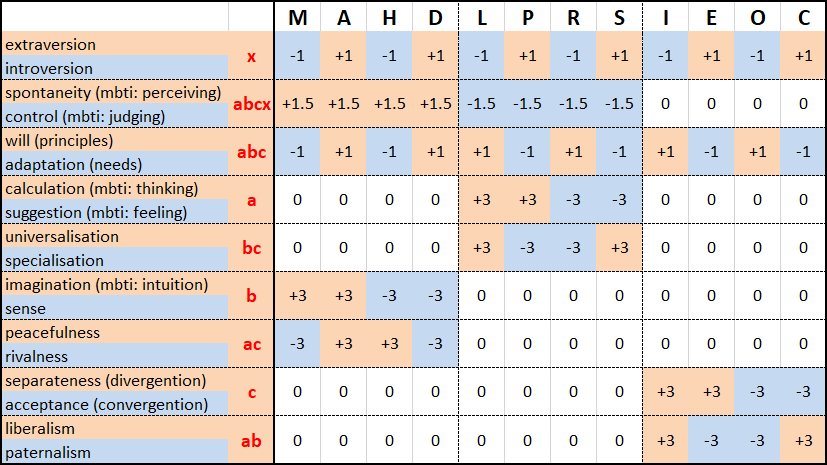
for example: M = −x +1.5*abcx −abc +3*b −3*ac
Part 3. Socionic functions and sociotypes as strategies of survival
Strategies defining the type of selection of the genotype and its cultural shell (what eventually forms this genotype and culture):
[ЧС] D: Tighter requirements for the accuracy of behavior reproduction (narrowing of the behavioral norm); tougher intraspecific competition; increasing the proportion of the contribution of genetics to behavior (instinctive behavior)
[ЧИ] A: Relaxing requirements for the accuracy of behavior reproduction (expansion of the behavioral norm); weakening of intraspecific competition; increasing the proportion of the contribution of language culture to behavior
[БЛ] L: Natural selection (guided by the global properties of the environment and the following from its models of the landscape and behavior on it)
[БЭ] R: Sexual selection (driven by factors of local genetic and cultural change and subsequent stylization of behavior)
[БК] I: Directional selection (progressive factor of evolution); strengthening the influence on the future of the species of the properties of the individual (unique mutations, genetic recombinations and the particular qualities of behavior they generate)
[БД] O: Stabilizing selection (conservative factor of evolution); strengthening the influence on the future of the species pre-existing collective genetic&cultural norms
Strategies defining the main way of extracting resources in interaction with the environment (and ultimately forming the properties of this environment):
[БС] H: Introduction of an ecotope into homeostasis (closure of ecological chains; potentially infinite resource in its dynamic circulation; cyclic time); best reproduced in homeostatic ecotopes
[БИ] M: Introduction of an ecotope into a crisis (opening of ecological chains; wasted finite resource in terms of volume; linear time); reproduction is tied to times of ecotope crisis
[ЧЛ] P: Independent (driven by the desire for personal gain) search for a resource; creation of a personal, separate economy, whose success depends only on the personal skills of the individual
[ЧЭ] S: Emotional & behavioral synchronization with the flock, were the search and distribution of the resource takes place; the success of an individual is inseparable from the success of the flock
[ЧК] E: Selectivity in the choice of a resource; narrowing of environmental conditions suitable for survival; dependence on the native ecological pyramid, outside which his survival is impossible
[ЧД] C: Omnivorous in the choice of resources; expansion of environmental conditions suitable for survival; embedding into existing ecotopes, reducing the originality of their ecological pyramids (cosmopolitans, "weeds")
ILE [ИЛЭ] {= +A−R−O} innovation strategy (staking on the discovery of new ecological niches and the spread of one's genome due to the "founder effect"; leads to allopatric speciation)
LII [ЛИИ] {= −D+L+I} intellectualization strategy (refusal of competition in order to avoid the cognitive distortions associated with it; stake on the global progress of intelligent life)
SEI [СЭИ] {= +H−P−E} symbiotic strategy (maintaining the homeostasis of the ecosystem as a whole due to the mutual satisfaction of the needs of all its participants)
ESE [ЭСЭ] {= −M+S+C} swarm strategy (following fashion for the sake of forming a flock, within which the consumption of all its members is synchronized and individual survival risks are reduced due to mutual aid)
SLE [СЛЭ] {= +D−R−I} strategy for enhancing natural selection (ambition to capture the top of the ecological pyramid, turning into absolute predator)
LSI [ЛСИ] {= −A+L+O} stabilizing selection strategy (preservation of the ecotope unchanged, including xenophobia and genocide against all newly emerging species and competing groups)
IEI [ИЭИ] {= +M−P−C} "attractiveness-parasitic" strategy (suggestion of pleasant illusions to the strong host, prompting host to keep the parasite with him, protect him and take care of him)
EIE [ЭИЭ] {= −H+S+E} provocateur's strategy (expressive influence on flock opinion in order to increase the activity of the society's struggle against the problems and enemies of the elite)
SEE [СЭЭ] {= +D−L−O} strategy for enhancing sexual selection (Machiavellian tricks development, "show off"-behavior for reproductive success)
ESI [ЭСИ] {= −A+R+I} highly selective sexual strategy (the desire for reproductive isolation aimed at clearing the genome of harmful mutations - which creates sympatric speciation)
ILI [ИЛИ] {= +M−S−E} "lone scavenger" strategy (searching for and tracking someone else's misfortune in order in a situation of general disunity to be the first to use the freed up resources)
LIE [ЛИЭ] {= −H+P+C} strategy of escalation of interpersonal competition (stimulation of intraspecific personal efficiency through a race of equals to create something useful from "nobody's" resources)
IEE [ИЭЭ] {= +A−L−I} promiscuous friendliness strategy (the expansion of ideas about the social norms leading to interpopulation communication and the emergence of a linguistic & cultural settings over the genotype)
EII [ЭИИ] {= −D+R+O} eusociality strategy (altruistic intra-group mutual assistance and tolerance, which weakens the pressure of selection on an individual and increases the phenotypic intraspecific diversity)
SLI [СЛИ] {= +H−S−C} peaceful-avoidance strategy (moving to the deep periphery and occupying a specialized ecological niche for which there are no more applicants)
LSE [ЛСЭ] {= −M+P+E} productive strategy for transforming the habitat (creating an artificial biotope by one's own work that more sustainably reproduces the resources necessary for the survival)
addendum 1. Comparison of semantic content MBTI and socionic functions
| flow of ideas; vision of variations of future | imagination of new possibilities; chaos of creativity; "childishness" - love for novelty and freedom |
moderate | ||
| insight | imagination of changes in time; passivity; self-absorbed contemplation; parasitism & unwillingness to make an effort to help; correlates with masochism | low | ||
| fullness of sensations here and now; hedonism | striving for dominance and usurpation the best resources - "alpha (fe)male"; correlates with the dark triad subtraits and sadism |
low | ||
| sensual memory, tradition and caution | comfort and relaxation; life here and now; maintenance of homeostasis & crisis avoidance | low | ||
| sociability and social involvement based on common values | following the ideals of attractiveness and managing the dramatic passions of the masses (fashion designers, prophets) | high (but not 100%) | ||
| empathy based on personal emotional experience and private values | management of private relations based on a superior understanding of personal characteristics of close people | high (but not 100%) | ||
| objective thinking; doing work to change the external world | the same as Te + professional specialization (leading to the rejection of any transpersonal universal meanings of life) | high (but not 100%) | ||
| analyzing and modeling reality in your mind | the same as Ti + stubbornness the reason for which is the principled adherence to the chosen ideological paradigm | high (but not 100%) | ||
addendum 2. Dispersion contribution of the 15 socionic dichotomy the overall diversity of personality traits
(based on the data of questionnaires created by V.L.Talanov's technology)
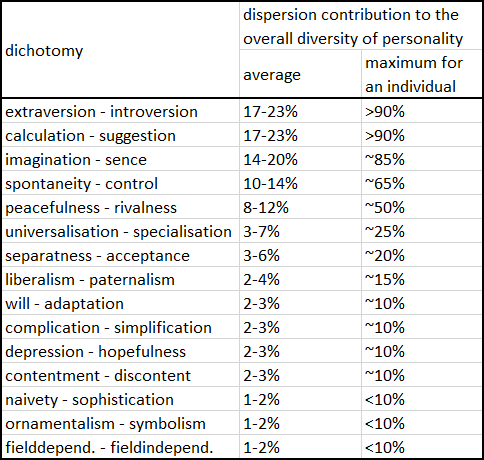
addendum 3. Recommendations for typing diagnostics:
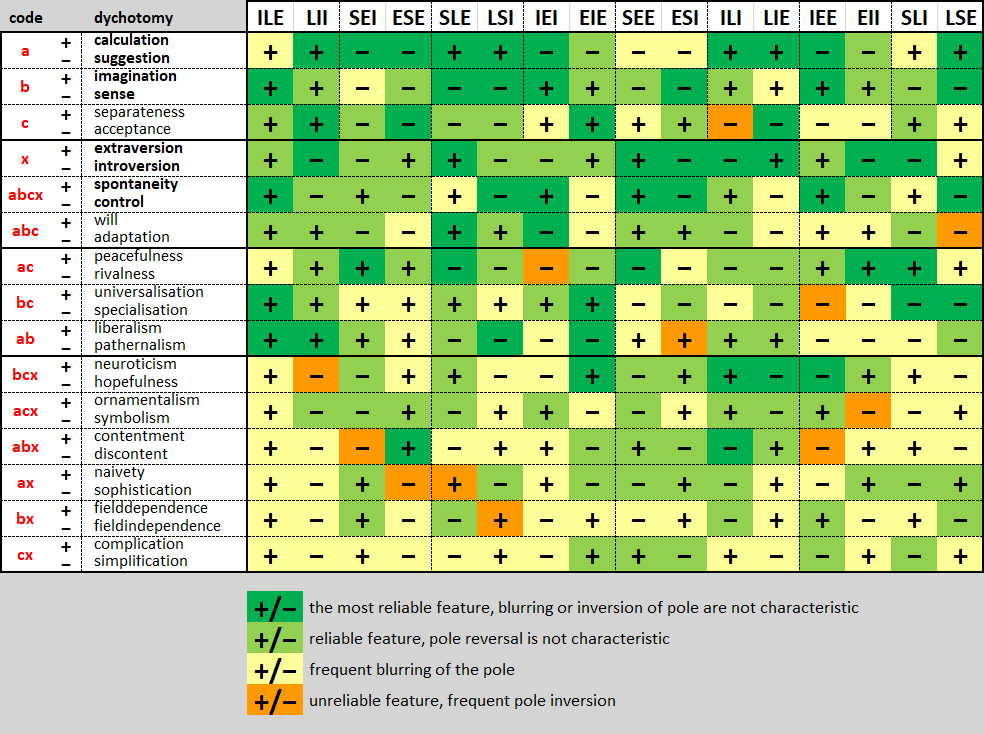
addendum 4. Various personal properties and character accentuations in the socionic coordinate system
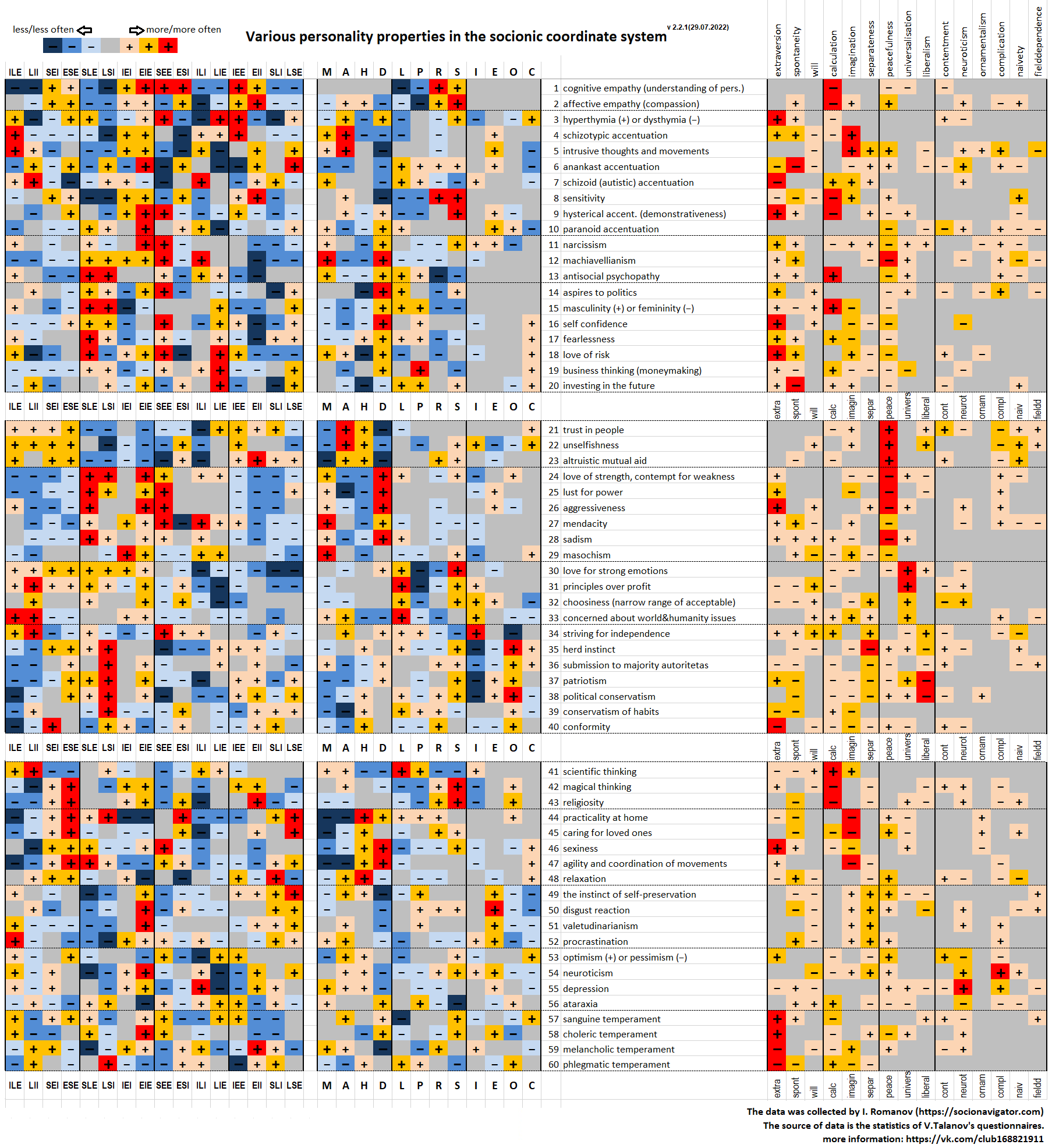
copyleft: Ivan Romanov, Saint-Petersburg, June 30, 2022
The author permits the free reproduction of information from this page provided that the source is hyperlinked.